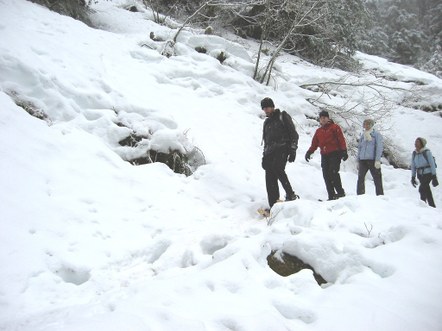Snowshoeing
beginner snowshoeing
Beginner snowshoeing trips are those in which terrain is flat or gentle with minimal avalanche danger, and are limited to Easy and Moderate routes. They are open to all properly equipped members and non-members of The Mountaineers.
No Prerequisites Required for Beginner Trips
basic snowshoeing
Basic snowshoeing trips are those which have no exposure to steep terrain which would require the use of an ice axe with minimal avalanche danger. Note that students must have successfully completed any field trip(s) prior to sign-up.
| Prerequisite Badges |  |
 |
 |
 |
 |
 |
Intermediate snowshoeing
Intermediate snowshoeing trips involve exposure to terrain that may require the use of an ice axe and/or the use of avalanche tools: beacon, probe, and shovel. Note that intermediate snowshoeing students must have successfully completed their field trip(s) prior to sign-up
| Prerequisite Badges |  |
 |
 |
 |
Difficulty Ratings
All snowshoe trips are rated for difficulty based on the following scale:
- Easy: Up to 750 ft. elevation gain, and up to 6 miles round trip. Most likely on an established trail or road.
- Moderate: Up to 1,500 ft. elevation gain, and up to 8 miles round trip.
- Strenuous: Up to 2,500 ft. elevation gain, and up to 10 miles round trip.
- Very Strenuous: Over 2,500 ft. elevation gain, or over 10 miles round trip.
It's important to have your winter weather clothing system dialed for snowshoe outings. Choose a trip with a mileage and elevation gain that suits your fitness and ability. Leaders often list pace by distance "speed" like 2.5 miles per hour or by elevation "speed" (e.g. 1000 feet per hour). Snowshoe trips often are far more strenuous than day hikes on the same route and often involve routefinding in avalanche terrain.
